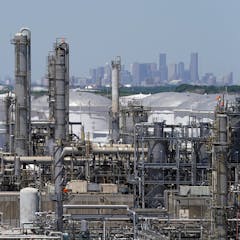
Artículos sobre PM2.5
Mostrando 1 - 20 de 28 artículos

For decades, big-box retailers have evaded federal regulation of the pollution their operations generate. But a new air emission rule in Southern California could become a model for state controls.

Reducing particle pollution can save thousands of lives, but states need more data to inform better controls. An atmospheric scientist explains what data and actions are needed.

Smoke from bushfires can travel significant distances and reduce air quality throughout a city or region.

On Feb. 7, 2024, the EPA strengthened the federal limit for annual levels of fine particulate air pollution, or PM2.5. Many serious health effects have been linked to PM2.5 exposure.

Researchers created a layer of human lung cells and exposed them to different pollutants.

The longest-running study of its kind reviewed death records in the path of pollution from coal-fired power plants. The numbers are staggering − but also falling fast as US coal plants close.

People with a lung condition are among those particularly vulnerable to bushfire smoke. But you can prepare for the season ahead.

Thick smoke pouring in from Canada’s wildfires canceled baseball games and pushed air quality in major US cities to the worst in the world.

The notion that wildfire smoke is ‘natural,’ and therefore less harmful than other types of air pollution, is not supported by the evidence. Wildfire smoke has been linked to adverse health effects.

Orangutans are vocal animals, so analyzing their calls during events like wildfires can indicate how smoke is affecting their health.

Fires in Canada have sent smoke across several US states, leaving cities including New York, Chicago and Denver with some of the worst air quality in the world – even far from the flames.

We’re all exposed to harmful air pollution when cooking – but retrofitting our homes to save energy may complicate matters.

Fry less, open doors and windows and switch to an electric stove if possible.

Air pollution causes chess players to make more errors – this may have implications for high-skilled professionals.

New research reveals that the London Underground is polluted with small particles which may carry negative health effects for humans.

The worst effects are during high nighttime temperatures, something happening more often with climate change. Wildfire smoke adds to the risk.

They look like conventional school buses, but electric versions are cleaner, quieter and cheaper to maintain. States, utilities and federal agencies are helping school districts make the switch.

Fires today are hotter and more destructive, thanks in part to a warming climate.

$13 billion would buy us safe air in schools and aged care facilities. It would give the same sort of benefits as safe water.

Pollution from more frequent floods and wildfires – exacerbated by the warming climate – is threatening human health and poses particular risks to the brain.
